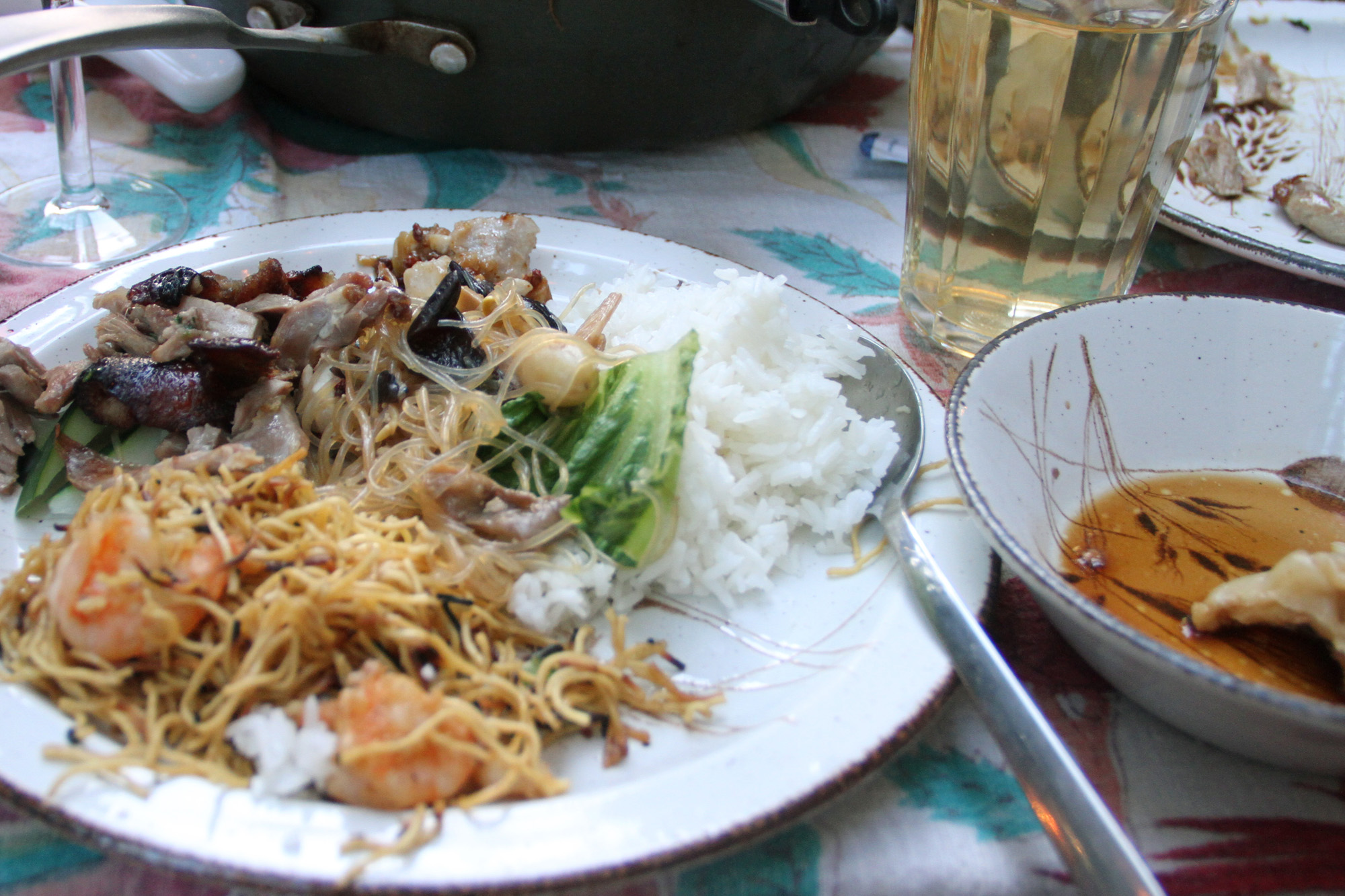When asked over the past year which upcoming meal intimidated me the most, I'd answer "China." The most populated country in the world covers a huge variety of cuisines, virtually uncountable ingredients and cooking techniques, and tremendous extremes: it has 9,100 miles of coastline and also the point on Earth farthest from any ocean. China is a telling example of the imperfection of using the United Nations member list as a proxy for the world's cuisines. But here we are.
Thanks to the thorough consultation and guidance of Chrys Wu, who gave generously of her time and knowledge to compile the menu (and then jumped in to help with the cooking!), I think we did about as well as we could have in a single meal in terms of variety on several dimensions: pork, duck, fish, seafood, tofu; steaming, pan-frying, roasting; rice, wheat, bean noodles; and heck, we even managed to include yogurt. A huge shout-out as well to Oliver, for making the trip from DC to shop and cook and enjoy, and bringing back memories of cooking Chinese food together in high school.
Our other guests were Sam, Jenny, Ben, and Caroline. Thankfully this on-again, off-again rain gave us a respite, and we enjoyed the meal outside — which is a good thing since the house got seriously smoky when we reheated the Peking duck!

Cha | Tea
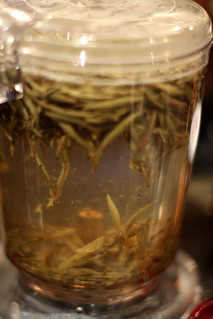
Chrys brought over some gorgeous white needle tea. It was just a bit hot out to enjoy the tea warm, so we iced it. Good decision! It was crisp but not too bitter, a nice contrast to the rich flavors we encountered throughout the meal.
Shanghai: Xiao long bao | Soup dumplings | Recipe
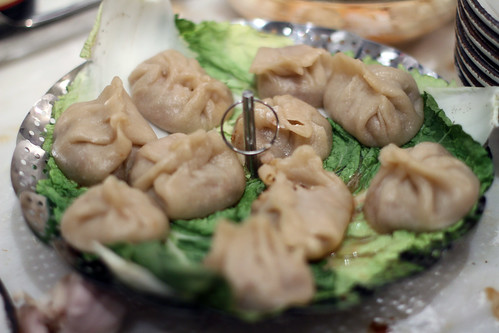
This is probably my single favorite dish in all of Chinese food, and so of all the dishes in the pantheon of Shanghainese cuisine, I insisted we make this one despite all the work. The day before, I made the broth, extracting the flavor from two pounds of chicken and a pound and a half of pork belly, boiling it down to a cup and a half of super-rich stock, and mixing it with gelatin. The next day, we mixed this gelled aspic with a rich, aromatic, pork-based filling, stuffed it into wheat-based dumpling skins, and steamed them until the skins got rich and glossy, and the aspic magically melted into soup. Eaten in one bite with a little splash rich Chinkiang vinegar (I like to call it the Balsamic of China due to its complexity), this explosion of textures and flavors is a fantastic appetizer.
Hong Kong: Yee mein | Pan-fried noodles with shrimp and scallops | Recipe

"Should I use the same marinade for the shrimp and the scallops?" I asked Chrys. "Oh no, then everything would taste the same," she cautioned. Thus I learned an important aspect of Chinese cuisine: even if everything is ending up in the same dish, keeping flavors separate allows the individual elements to carry their own identity. What a tasty and easy-to-prepare dish: provided you've got the right sauces and noodles on hand, you can make this with pretty much any land- or sea-based protein in a matter of minutes. Tasted arguably better as leftovers the next day!
Guangzhou/Canton: Hoi sam | Sea cucumber stuffed with pork and shrimp | Recipe

Whenever I hear the term "flavorless, gelatinous delicacy," I grow skeptical. And as you can see, these sea-lubbers ain't exactly lookers, nor are they cheap. But you know what, this dish turned out well. If you think of the pork-and-shrimp filling as a hotdog, this salad-of-the-sea made for a nicely chewy but not at all tough bun of sorts.
Sichuan: La zi yu | Fish with chilies and sichuan pepper | Recipe

Though drenched in chilies and Szechuan peppercorns, this dish was somehow really pleasant and well-balanced. We started with some sea bass that I bought live in Chinatown, and filleted using the knife and the skills I picked up at Brooklyn Kitchen's Knife Skills 201 class. Oliver made the spicy base and the even spicier oil for on top, while I sliced the fish into chunks and boiled it in water, before we put it all together. Why boil the fish rather than fry it in that spicy oil? Maybe that's why the heat is manageable. Also, if you've never had a Szechuan peppercorn experience, this dish is a first-class way to experience the tangy, tingly, numby, intense flavors of this mysterious spice.
Beijing: Kao ya | Peking duck | Recipe
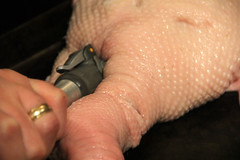
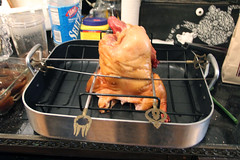



Since I don't have a vertical roaster, and I avoid buying cooking equipment for single uses, we had to get creative, and Oliver had the great idea of using skewers to keep the duck propped upright. And it worked! You can see how beautifully bronzed our duck turned out. The only problem we ran into was in the reheating right before service: we had the oven up too high, and it filled the house with smoke. (Oh, and the pancakes we bought that are traditionally used as little fluffy tacos were moldy and so we tossed them. Oh well!) While we got surprisingly little meat from this five-pound bird, it was sure tasty.
Luo han zhai | Buddha's delight | Recipe
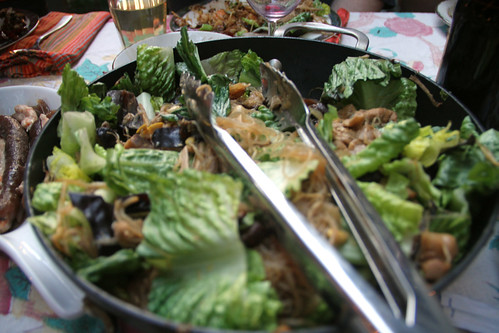
To represent the Buddhist traditions of the southern highlands, and also to insert some veggies into the meal, we made what's known in English as Buddha's Delight, a vegetarian stir-fried dish that's traditionally eaten for the new year. Taking cues from various recipes around the internet, we went a bit nuts with the varieties of fungus, including wood ear and bamboo fungus, and so it had quite the earthy flavor. We're also not positive the romaine lettuce is entirely authentic. But it was definitely flavorful and abundant.
Xinjiang: Durap | Sweetened yogurt

I'll be honest, I'm not a big fan of typical Chinese desserts. So I jumped on the opportunity to acknowledge the Uyghurs of far Western China, and make this dish of yogurt sweetened with honey and lemon juice and thinned with shaved ice. We couldn't find a recipe for durap, only descriptions, so we had to wing it. And I think it was pretty good!
I'm happy to say we ended up with surprisingly few leftovers given the abundance of this feast — our guests were eatin' champs! And now our attention turns to Colombia, where with the bandeja paisa they've managed to create that treasure that's rare and highly appreciated here in Noshlandia: a single dish that incorporates the essence of the country's cuisine. See you next week!
